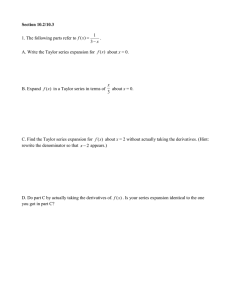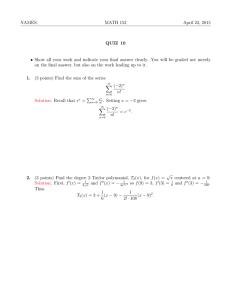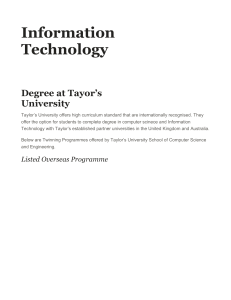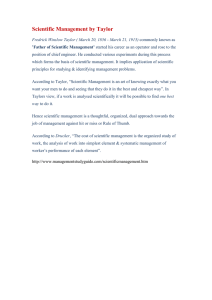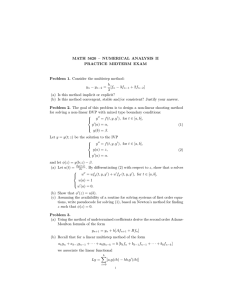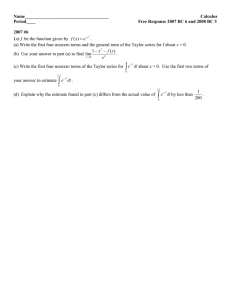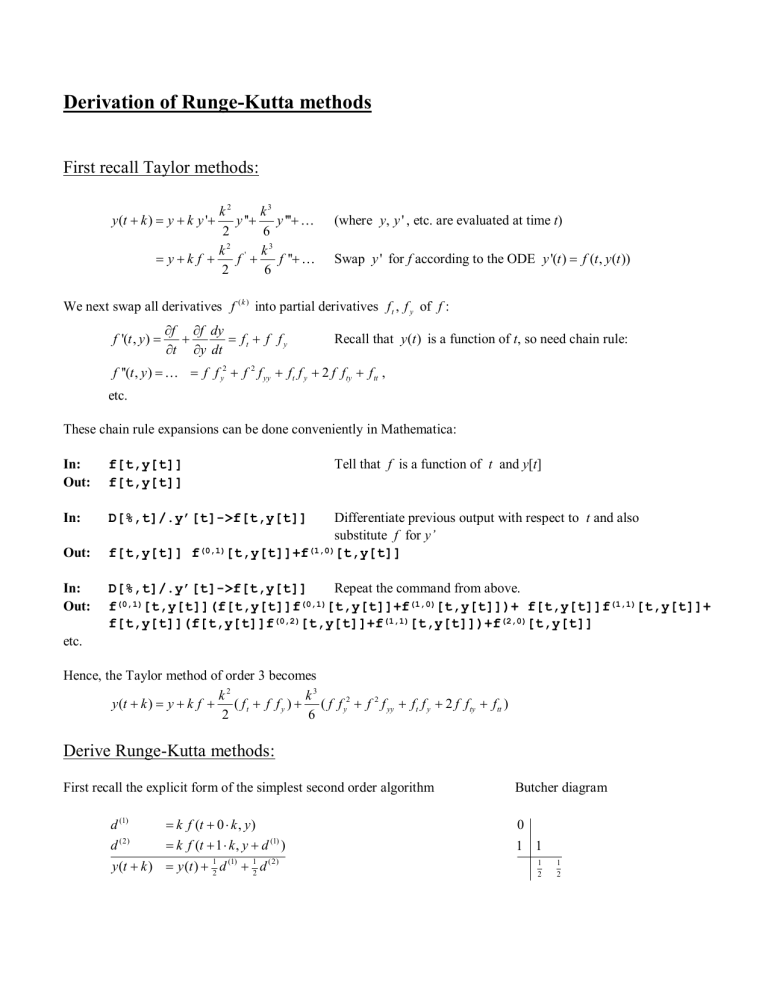
Derivation of Runge-Kutta methods
First recall Taylor methods:
k2
k3
y ''
y '''
2
6
k2 ' k3
yk f
f
f ''
2
6
y (t k ) y k y '
(where y, y ' , etc. are evaluated at time t)
Swap y ' for f according to the ODE y '(t ) f (t , y (t ))
We next swap all derivatives f ( k ) into partial derivatives f t , f y of f :
f '(t , y )
f f dy
ft f f y
t y dt
Recall that y (t ) is a function of t, so need chain rule:
f ''(t , y ) f f y2 f 2 f yy f t f y 2 f f ty f tt ,
etc.
These chain rule expansions can be done conveniently in Mathematica:
In:
Out:
f[t,y[t]]
f[t,y[t]]
In:
D[%,t]/.y’[t]->f[t,y[t]]
Out:
In:
Out:
Tell that f is a function of t and y[t]
Differentiate previous output with respect to t and also
substitute f for y’
(0,1)
(1,0)
f[t,y[t]] f
[t,y[t]]+f
[t,y[t]]
D[%,t]/.y’[t]->f[t,y[t]]
Repeat the command from above.
f(0,1)[t,y[t]](f[t,y[t]]f(0,1)[t,y[t]]+f(1,0)[t,y[t]])+ f[t,y[t]]f(1,1)[t,y[t]]+
f[t,y[t]](f[t,y[t]]f(0,2)[t,y[t]]+f(1,1)[t,y[t]])+f(2,0)[t,y[t]]
etc.
Hence, the Taylor method of order 3 becomes
k2
k3
y (t k ) y k f ( f t f f y ) ( f f y2 f 2 f yy f t f y 2 f f ty f tt )
2
6
Derive Runge-Kutta methods:
First recall the explicit form of the simplest second order algorithm
d (1)
d
(2)
k f (t 0 k , y )
0
(1)
1 1
(2)
1
2
k f (t 1 k , y d )
1
2
y (t k ) y (t ) d
(1)
1
2
d
Butcher diagram
1
2
To find the coefficients of a general RK method of order 2:
d (1)
d
k f (t 0 k , y )
(2)
0
(1)
k f (t c1 k , y ad )
y (t k ) y (t ) b1d
(1)
b2 d
(2)
c a
b1 b2
we Taylor expand d (1) and d (2) to second order:
In:
Out:
d1 = Series[k f[t_,y[t_]],{k,0,2}]
f[t_,y[t_]]k + O[k]3
In:
Out:
d2 = Series[k f[t_+c k,y[t_]+a d1],{k,0,2}]
f[t_,y[t_]]k+(a f[t_,y[t_]]f(0,1)[t_,y[t_]]+c f(1,0)[t_,y[t_]])k2 + O[k]3
and the combine the two:
In:
Out:
b1 d1 +b2 d2
(b1 f[t_,y[t_]]+b2 f[t_,y[t_]])k +
b2(a f[t_,y[t_]] f(0,1)[t_,y[t_]]+c f(1,0)[t_,y[t_]])k2 + O[k]3
i.e.
y (t k ) y (t ) k (b1 b2 ) f k 2 (b2 c f t b2 a f f y ) O (k 3 )
For an arbitrary function f (t , y ) , this matches the Taylor method of the same order if and only if
b1 b2
b2 c
ba
2
1
1
2
1
2
We can choose b1 and b2 arbitrary, subject to b1 b2 1 . The values for c and a then follow. The particular choice
b1 b2
1
2
gives the 2-stage second order method we first quoted.
This derivation procedure generalizes to RK methods of higher orders. For example, to generate 4-stage RK methods of
order 4, we would start with
0
c1
c2
a11
a21
a22
c3
a31
a32
a33
b1
b2
b3
b4
and then follow the procedure above to 4th order of accuracy. This turns out to give 9 compatibility conditions in 13
unknowns. For higher still orders of accuracy, the number of compatibility conditions increases rapidly, making it
impossible to find p-stage methods of order p for p 4 . Furthermore, these (generally nonlinear) compatibility
conditions become increasingly difficult to find solutions to.
